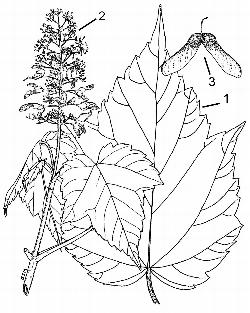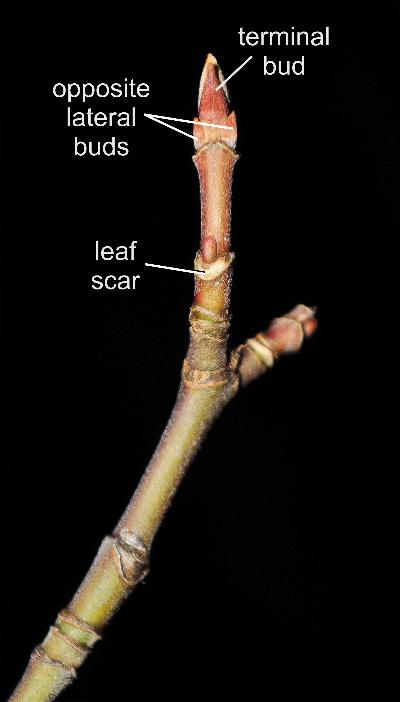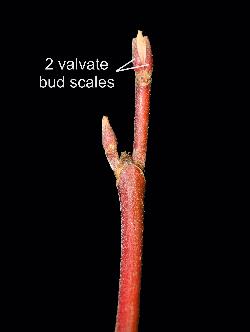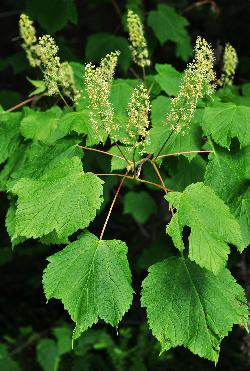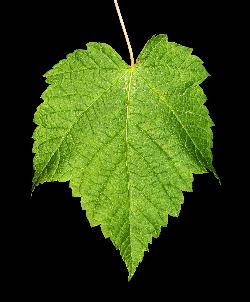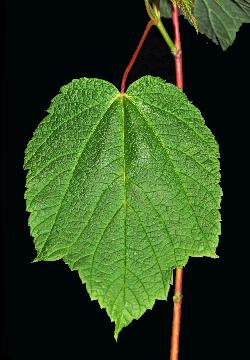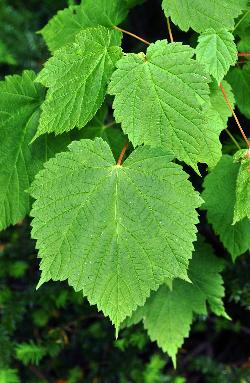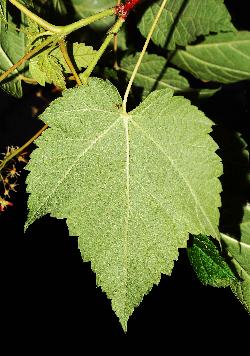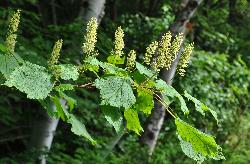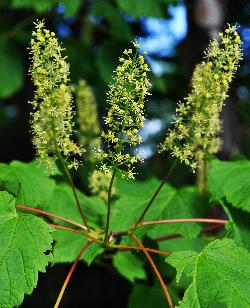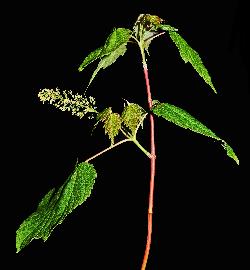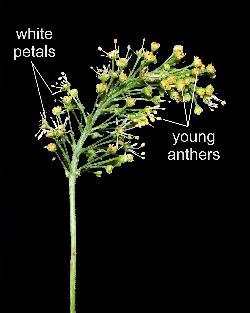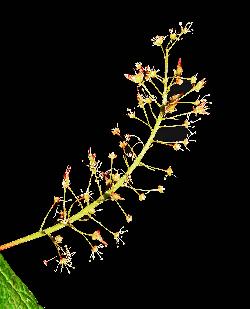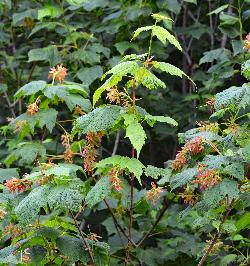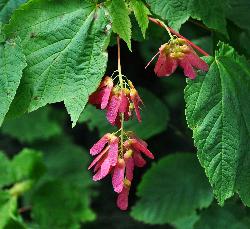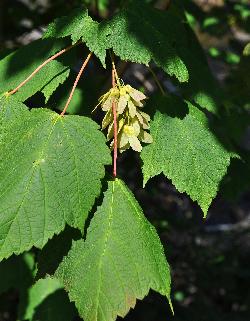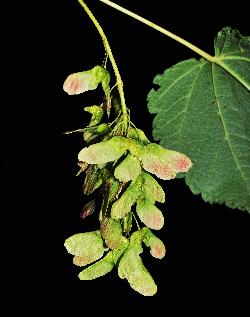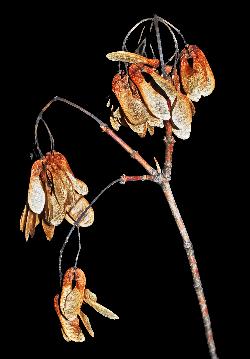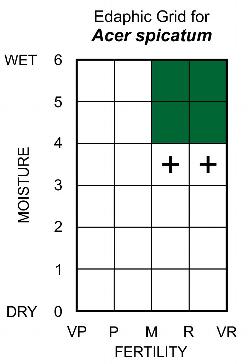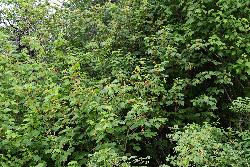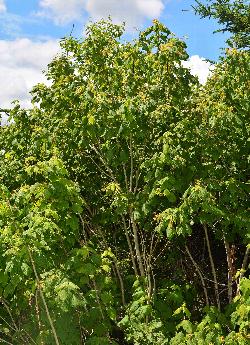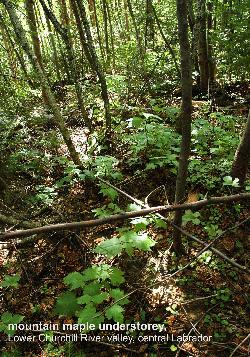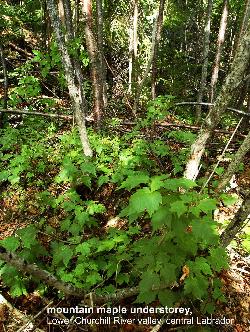Fr: érable à épis, érable bâtard. plaine bleue
IA: upueiashku
Sapindaceae - Maple Family
Note: Numbers provided in square brackets in the text refer to the image presented above; image numbers are displayed to the lower left of each image.
General: A tall shrub to short deciduous tree [1–2], 5–10 m tall, with a d.b.h. of 25 cm, and living to about 100 years (Farrar 1995). Mountain maple is a shade-tolerant, shallow-rooted understorey species that provides browse for moose, snowshoe hares, and woodland caribou; its wood is not used commercially.
Key Features: (numbers 1–3 refer to the illustration [3])
- The central lobe of the leaf blade is triangular with coarsely-toothed margins.
- Flowers are small and numerous, arranged in a narrow erect panicle.
- The angle between the two wings of the samaras in mountain maple varies, but is less than 90° and wider than the angle between wings in red maple samaras.
Stems/twigs: Twigs and buds are finely hairy, olive green, greenish-brown, reddish-brown, or red. The terminal and opposite lateral buds are slightly stalked, ellipsoid, and pointed (acute) at the tip, with 2 valvate bud scales; leaf scars are broadly V- to U-shaped with 3 bundle trace scars [4–5]. The bark of older stems is reddish brown to greyish brown and glabrous, mature stems have shallow-furrowed bark.
Leaves: Opposite, simple, palmately lobed and veined, and petiolate [6–7]. The long petioles are 3–13 cm long, often longer than the leaf blade, and red or reddish-green in colour. Leaf blades are broadly ovate to orbicular, 6–12 cm long, with 3 short triangular lobes that taper gradually to a pointed (acute to acuminate) apex; a pair of smaller lobes may be present towards the leaf base [8–10]. The angle between the central and lateral lobes is broadly V-shaped, more than 90°. Leaf surfaces are glabrous, yellow-green to dark green, and coarse-textured (rugose) above, paler and finely hairy beneath [11]; leaf bases are cordate; margins are coarsely toothed (serrate). In autumn, the leaves turn orange to bright red.
Flowers: Mainly unisexual, with male and female flowers on the same tree (plants monoecious). Flowers are arranged in terminal erect branched inflorescences (panicles), 3–8 cm long [12–15]. The central axis (rachis) of the panicle and flower stalks (pedicels) are finely pubescent. Flowers are up to 1 cm across, with 5 yellowish-green narrowly oblong sepals, 1–2 mm long; petals 5, white, oblanceolate, 3–5 mm long [16]. Male and female unisexual flowers may occur in the same panicle [17]; male flowers have 8 stamens attached to the outside of a lobed central nectar disk; female flowers have a superior ovary with 2 winged carpels and 2 styles [18], which are stigmatic along the inner surface. Flowers bloom after the leaves have emerged and are pollinated by insects (entomophily).
Fruit: Pairs of winged samaras (maple keys) are attached in pendant clusters to a central axis (rachis). Each samara is 1.5–2.5 cm long; the obovate wings are divergent to downward-pointing; the angle between the two wings is less than 90°. The surface of the seed case is indented on one side, rounded on the opposite side. Immature samaras may be yellow, green, pinkish, or red [19–22]; but become brown and veiny at maturity in late summer [23]; dispersal is by wind (anemochory).
Ecology and Habitat: Acer spicatum occurs on nutrient-rich, moist to wet sites with a mucky surface horizon. Soil types range from gleyed podzols to gleysols and shallow organics with seepage in the rooting zone. The most common landscape positions are lower slopes on rich tills and alluvial deposits along streams that experience annual flooding. In mature forests, mountain maple usually occurs in small patches under canopy openings, where it can attain heights of 10–12 metres.
Edaphic Grid: See image [24]: the Edaphic Grid for Acer spicatum.
Forest Types: Mountain maple most frequently occurs in the following mature forest associations/subassociations:
- Abietum dryopteretosum (Dryopteris-Balsam Fir Forest Subassociation)
- Abietum rubetosum (Rubus-Balsam Fir Forest Subassociation)
- Aceretum caricetosum (Carex-Mountain Maple Thicket Subassociation)
- Aceretum galietosum (Galium-Mountain Maple Thicket Subassociation)
- Alneto-Piceetum (Alder-Black Spruce Swamp Association)
Succession: Following disturbance by logging in these associations, mountain maple can form extensive thickets [25–26] classified as the Aceretum spicatae (Mountain Maple Thicket Association). These thickets retard the regeneration of conifers for lengthy periods on what otherwise would be highly productive forest sites. Mountain maple thickets rarely form after fire disturbance due to competition from Betula papyrifera and Betula alleghaniensis, which form the mature forest subassociations Betuletum-dryopteretosum (Dryopteris-White Birch Forest Subassociation) and Betuletum rubetosum (Rubus-White Birch Forest Subassociation). However, Acer spicatum can be a significant understorey component of these fire stands. It also occurs sporadically in the alluvial alder swamps, Alnetum caricetosum (Carex-Alder Swamp Subassociation).
Distribution: Mountain maple is found naturally throughout southeastern Canada and northeastern United States, where it extends from Newfoundland and Labrador west to Saskatchewan, south to Connecticut, Pennsylvania, Ohio, Michigan, northeastern Iowa, and in the Appalachian Mts., to western North Carolina and eastern Tennessee. Within Newfoundland and Labrador, mountain maple is most common in the mountainous areas of western Newfoundland, where there are extensive seepage slopes. Mountain maple is rare In Labrador, restricted to a small area of the Churchill River Basin, from Goose Bay to west of Gull Island [27–28].
Similar Species: Mountain maple is similar to red maple (Acer rubrum L.), but the two species are easily differentiated by leaf and floral traits. Mountain maple has 3 triangular lobes that taper gradually to the apex, while red maple has shouldered lobes (indented upwards in a step-like manner), with the base of the central lobe characterized by nearly parallel sides. Mountain maple has flowers arranged in elongate terminal panicles, erect to spreading, with mainly yellowish-green flowers that bloom after the leaves have emerged, while red maple has small, nearly sessile clusters of red flowers that bloom well before the leaves emerge.




